The Alaska Seafood Marketing Institute (ASMI) contracted with McDowell Group, an Alaska-based research firm, to measure the economic impact of the Alaska seafood industry in the state of Alaska (statewide and regionally), in Washington State, and in the US economy overall. This report considers all of the direct, indirect, and induced economic effects of the Alaska seafood industry, including the entire value chain, from harvest to retail sales. The report also provides background information on harvest volume and value, production volume and value, and participation within Alaska's seafood industry. Following are key findings from the study.
Impact of Alaska’s Seafood Industry on the US Economy
- Alaska seafood directly accounts for 94,000 workers who, in total, earned $2.8 billion in 2011. This figure consists of American workers who caught, processed, managed, sold, cooked, or served Alaska seafood. On an average monthly basis, Alaska seafood directly created 61,200 US jobs in 2011.
- The combined value of Alaska seafood exports and the retail value of Alaska seafood sold in the US totaled an estimated $6.4 billion in 2011.
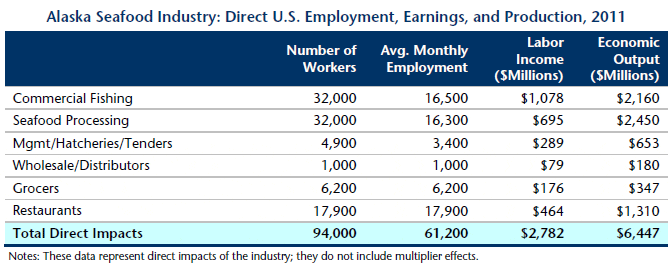
- Estimates of direct economic effects do not include multiplier effects, i.e., jobs and income created as a result of business and personal spending connected to the Alaska seafood industry. Including multiplier effects, the Alaska seafood industry is the basis for over 120,000 US jobs, employing over 165,000 people, and $6.4 billion in labor income.
- Total direct and secondary economic output in the US stemming from the Alaska seafood industry was estimated to be $15.7 billion in 2011.
- The Alaska seafood industry directly employed 63,100 workers in Alaska during 2011. An additional 78,400 jobs were created elsewhere in the US related to Alaska seafood resources. Put another way, for every Alaska fisherman, processor, or direct support worker; an additional 1.24 US jobs were created by the Alaska seafood industry.
- Most jobs associated with the Alaska seafood industry are connected to commercial fishing, processing, or other direct support sectors. Employment related to grocers and restaurants selling Alaska seafood only accounts for about one third of the total direct employment created by the industry. Since most jobs associated with the Alaska seafood industry are related to catching, processing, and managing the resource, it has a much greater economic impact on the US economy than imported seafood.

Alaska’s Role in the National Seafood Supply
- Based on available data – and reasonable extrapolations where data is not available – Alaska seafood accounts for roughly 10 percent of the total US seafood supply (by value, including domestic production and imports).
- About two-thirds of all Alaska seafood is exported abroad; seafood caught in Alaska accounts for 58 percent of all US seafood exports ($3.2 billion in 2011). It is estimated that the US market bought roughly 820 million pounds of Alaska seafood in 2011, worth $2.0 billion (in wholesale terms).
- Alaska accounted for 56 percent of total US commercial fishery harvest volume and 36 percent of total US ex-vessel value in 2011.
- Alaska seafood accounted for an estimated 34 percent of all domestically-produced seafood consumed in the US by volume, and 40 percent by value, in 2011.
- Despite a possible perception amongst some consumers that “all salmon comes from Alaska,” the US actually receives most of its salmon from foreign farms. Although Alaska produces 95 percent of all salmon caught in the US, wild Alaska salmon only represent about 23 percent of the total US salmon supply.
- The US, as a whole, bought roughly $21.0 billion worth of seafood in 2011 (in wholesale terms). Imports accounted for 79 percent, or $16.6 billion, while domestically-produced seafood accounted for 21 percent, or $4.4 billion, of the US seafood supply.
- Alaska seafood is a unique economic asset. The industry is primarily an export-oriented industry, generating $3.2 billion in exports in 2011. By injecting new money into the economy, exports can be a powerful economic stimulus. Despite exporting 2 billion pounds, Alaska is still the largest supplier of domestically-produced seafood in the United States. The US imports nearly 80 percent of its seafood supply.
Economic Impact of the Seafood Industry in Alaska
- The seafood industry directly employs approximately 63,100 people in the state of Alaska. Roughly 1-in-8 workers in Alaska earned at least part of their annual income directly from the seafood industry in 2011.1 These direct jobs produced $4.6 billion worth of wild, sustainable seafood (in wholesale terms) and resulted in an estimated $1.7 billion in labor income.
1 Based on employment data from the US Census (American Community Survey) and ADOLWD (Nonresidents Working in Alaska)
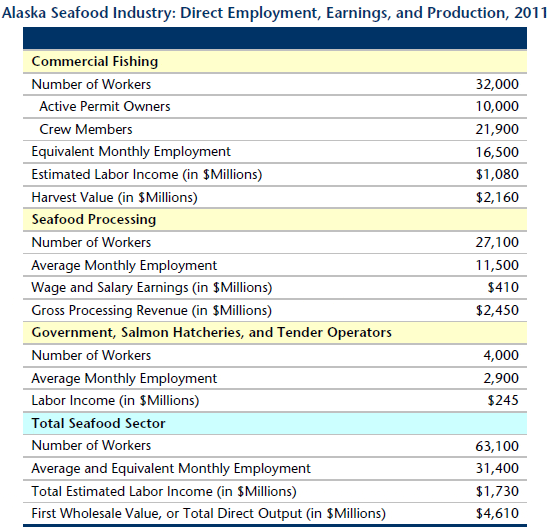
- Estimates of direct economic effects do not include jobs and income created in Alaska as a result of business and personal spending stemming from the seafood industry. Including indirect and induced (multiplier) impacts, the Alaska seafood industry is estimated to create jobs for 77,400 people in the state of Alaska. (See table below).
- Including multiplier effects, the seafood industry provided $2.2 billion of labor income and $6.8 billion in total economic output within the state of Alaska in 2011.
- It is estimated that the seafood industry directly or indirectly employs 1-in-7 civilian workers in Alaska and accounts for 9 percent of all civilian labor income earned within the state of Alaska.

Economic Impact of Commercial Seafood Industry on Alaska Residents
- The seafood industry directly employed an estimated 27,230 Alaska residents in 2011. This figures includes 18,050 commercial fisherman claiming residency in Alaska.
- Commercial fishing employs approximately two out of three residents who are directly employed by the Alaska seafood industry. The other third are employed in seafood processing (5,510 residents) and other industry support functions (3,670).
- Including multiplier effects, the Alaska seafood industry was responsible for an estimated 41,530 Alaska resident workers in 2011 and $1.28 billion in labor income earned by Alaska residents.
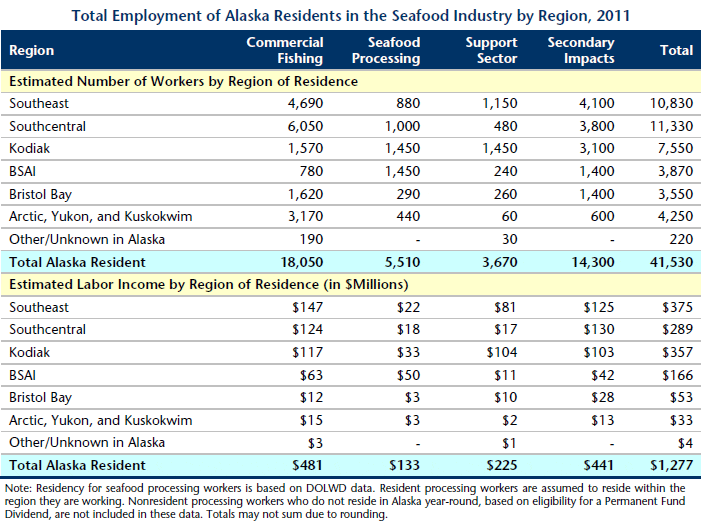
- The majority of Alaska residents who directly participate in the seafood industry reside in the Southcentral region, yet that region has the lowest industry participation rate when compared to the overall population of each region (see chart on following page). This fact illustrates a key point about Alaska’s seafood industry; while it does employ thousands of people from Alaska’s more populated areas, the several thousand jobs it provides in western regions and within parts of Southeast and Southcentral Alaska are critically important to those regional economies.
- In western Alaska, from Kodiak to Bristol Bay, more than one-in-four residents are employed in the seafood industry at some point during the year. Among the population in these regions aged 20 to 69 (working age), more than 40 percent are directly employed in the seafood industry.
Role of Commercial Seafood Industry in Alaska’s Economy
- The seafood industry directly employs an estimated 6 percent of all residents between the ages of 20 and 69.
- It is estimated the industry directly accounted for 7 percent of all private sector resident earnings in 2011. Amongst basic sectors, the seafood industry ranks second to the oil/gas industry in terms of resident earnings. Other sectors, such as health care, construction, and trade had higher resident earnings than the seafood industry, but these sectors are different in nature as they are primarily engaged in selling goods/services within the state economy as opposed to creating value from naturally occurring resources (or bringing new money into the economy, as the oil/gas, seafood, visitor industry, and other basic sectors do).
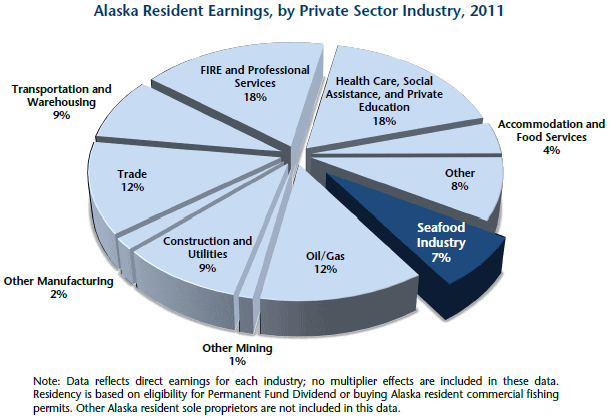
- Making comparisons like the one shown above is difficult. The significance of the seafood industry is not well known because economic data collected by government agencies is not collected on the commercial fishing industry in the same way it is collected for other industries. The analysis done for this report went to great lengths to estimate employment and labor income in a fashion that could be compared to data collected on other industries.
- Including direct and secondary impacts, the commercial seafood industry accounts for 9 percent of all jobs in Alaska.2 In 2011, the industry provided full and part-time jobs to 77,400 people and paid out an estimated $2.2 billion in labor income. In terms of the number of workers employed, the commercial seafood industry is the state’s largest private sector employer.
2 On a monthly average or equivalent basis. - The Alaska seafood industry creates more labor income and employs more workers in Alaska than the visitor industry and mining industry combined.
- The seafood industry is Alaska’s second largest basic sector industry, in terms of employment created, labor income, and production (including secondary impacts). It is the biggest industry in terms of exports. Seafood is also a renewable resource, which can provide economic benefits for Alaska for centuries if properly managed.
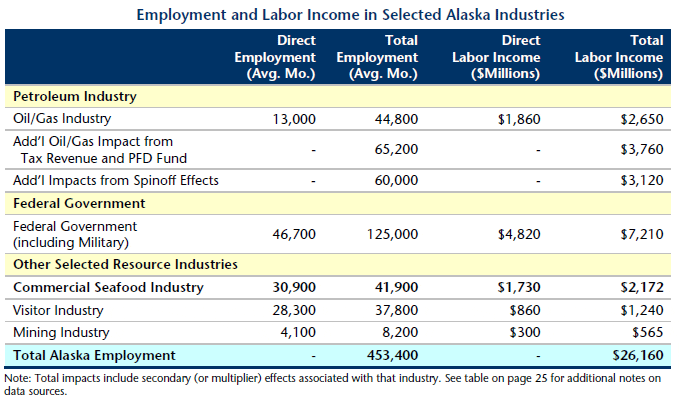
- Seafood backhaul lowers northbound shipping rates, which lowers the cost of living in coastal Alaska communities. A major Alaska shipper estimates northbound rates would be 10 percent higher in Alaska if not for seafood.
- The CDQ program includes six groups, which represent 65 traditional Alaska Native villages in western Alaska. These groups have grown to become important economic engines in western Alaska and the state as a whole. In 2011, the groups accomplished the following:
- Funded 1,600 training and scholarship opportunities for regional residents,
- Invested $30 million in community infrastructure projects and community benefit projects,
- Created 2,410 wage and salary jobs with annual payroll exceeding $45.5 million,
- Paid out a total of $32 million to 1,360 permit holders and 2,000 crew members, and
- Held net assets of approximately $800 million.
Economic Impact of Alaska’s Seafood Industry in Washington State
- The Alaska seafood industry created an estimated 34,500 jobs and $1.9 billion in labor income for Washington residents in 2011.
- Based on government licensing data and industry sources, it is likely that over 10,000 Washington residents physically worked in Alaska during 2011 as a commercial fisherman/woman or for a seafood processing company.
- It is estimated that over 7,000 additional Washington residents are directly employed in Washington State by processors, government agencies, distributors, grocers or restaurants, which are supported by Alaska seafood.
- Although the state of Washington is much more populous than Alaska, an industry located outside of the state generating 34,500 jobs and $1.9 billion in labor income is still very significant. Based on these findings, it can be concluded that roughly 1 percent of all jobs held by Washington residents are created by the Alaska seafood industry.
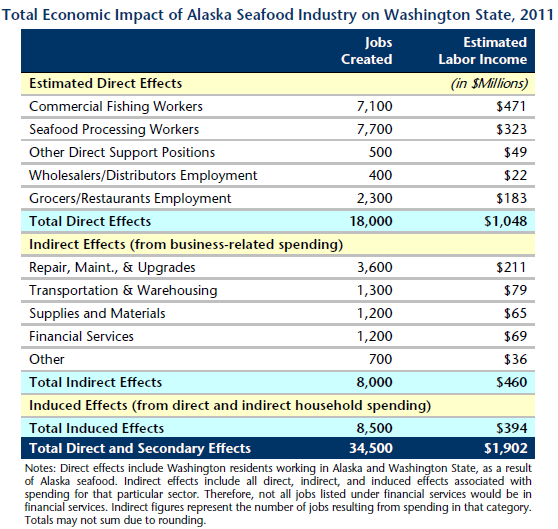
Further ReadingYou can view the full report by clicking here. |
September 2013



